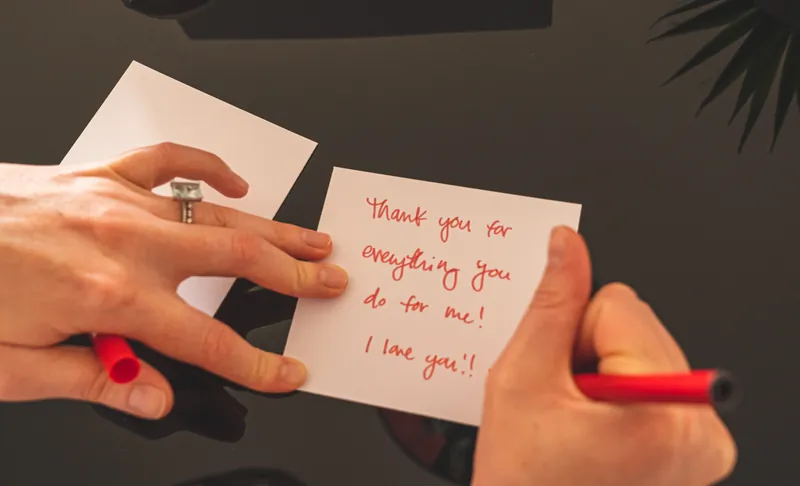I’m certain we can all remember the beginning of our relationships, right? The infatuation phase!
We’re in a love bubble that seems to dim or hide any of the negative (or simply different) traits that our spouse has. It just seems easy to mesh and be one. Making concessions is easy, dating is easy, making time is easy.
Anyone who’s been married for more than a few years can also probably identify when that initial infatuation wore off. Reality set in and everything that the love bubble was masking is now on full display! Annoyances are easy and we revert back to wanting things our own way.
This moment is a turning point. You’re faced with the reality that your spouse is not perfect and you must either choose to love them through their differences OR abandon ship.
Staying Newlywed means we must understand each other and honor who we are and who we married. But how do we do this? We read a book that I think many of you probably have heard of, but maybe you haven’t really dove into understanding it. The love language concept has been transformative for our marriage and we hope it can impact yours as well.
Disclaimer: This post includes affiliate links, and we will earn a commission if you purchase through these links. Please note that we've linked to these products purely because we recommend them and they are from companies we trust. There is no additional cost to you.
The 5 Love Languages Book Review
The 5 Love Languages, The Secret to Love That Lasts was written by Dr. Gary Chapman. It is a #1 New York Times Best Seller that was written in 1992, has been updated several times and sold over 20 million copies. Dr. Chapman is an author, speaker and marriage and family counselor.
He begins the book by identifying the ebb and flow of feelings in a marriage through a story of a man married three times. This man was business smart and ran a company, but didn’t understand why he couldn’t figure marriage out. All of his marriages ended when the feeling faded. Why do the feelings always fade?
Dr. Chapman uses plenty of real life conversations he’s had with married people. What I really appreciated was how in depth the detail about the issues these marriages were facing was and how he suggested they work to restore their connection.
He goes on to explain that we all have internal “love tanks.” They are our emotional gauge of how well we are being loved. Something hurtful, neglectful or not in our love language can cause a withdrawal from our love tank. The deposits come when our spouse clearly communicates their love to us in a way that we can relate to and understand.
It’s common to hear people say that men and women speak a different language. Dr. Chapman teaches that we all have different languages despite our gender, which we believe is a much more accurate depiction of our world.
He calls them our love languages. They are the way we give and receive love:
Words of Affirmation
A person who’s primary love language is Words of Affirmation feels secure in love by hearing you express it to them verbally or written. It could be in the form of encouragement, compliments or approval, but it also includes things like the tone of your voice and your kindness.
Quality Time
Quality Time is not just existing in the same space. There is emphasis on the word quality - so sans phone or other distractions. This is one-on-one time that includes focused attention and good conversations.
Physical Touch
From something simple like holding hands while taking a walk to a hug and kiss when you see them. Someone who appreciates physical touch needs you to initiate that touch attention a lot more than just in the bedroom.
Acts of Service
Ever thought that food is the way to someone’s heart? Well cooking for people is an act of service! Taking over someone’s chores or completing a “honey-do” list is another way to show them love.
Receiving Gifts
While birthday, Christmas and anniversary gifts would definitely fall under this love language, it includes so much more. Receiving anything that they know reminds you of them is a perfect way to give them love.
Examples from the book
I made a note of two great examples from the book. I think that many couples will be able to relate to them.
A woman has been nagging her husband for months and months to paint a room in their home. She has given up that her husband will ever do what she says and calls him lazy.
A man is irritated that he works so hard for his family and his wife never is in the mood for sex.
Both of their spouse’s love tanks are empty which makes them less willing to accommodate their spouse’s requests. The resolution to both of these problems are not what you might initially think. Dr Chapman counseled them to look at the situation differently.
The woman nagging, who called her husband lazy, has a husband who needs to hear words of encouragement. Nagging and name calling was actually creating a costly withdrawal from her husband’s love tank. She was instructed to never bring up painting the room again and to instead say thank you to her husband more often for normal things like taking out the trash.
The irritated man was instructed to stop coming home from work so late every day. His wife needs him to spend time with her in order to feel loved, while he assumed that providing a paycheck was what she wanted.
Both of these individuals have different love languages from their spouses. Once they understood how their partners' love tanks get filled, the change in communication brought an increase of peace, intimacy and feelings of love back to their relationships.
Do you know how you and your spouse’s love tanks get filled?

Identify your love language
Which of these scenarios would make you feel the most loved?
- A sticky note from your partner on the bathroom mirror telling you to have a great day
- Having dinner together - without phones or the tv as your focus
- Holding hands while you drive in the car or while on a walk
- Your spouse doing the dishes without being asked
- Your spouse picking up your favorite pint of ice cream on their way home from work
Just from the short descriptions you can probably already pinpoint your primary love language. Confirm yours by heading over to the official 5 Love Languages website to take the quiz for yourself.
Don’t worry if you get different results from your spouse, it’s completely normal. Dr. Chapman says that it’s actually pretty rare for spouses to have the same primary love language.
My primary love language is Words of Affirmation while Jake’s is Quality Time. I’m a pro at existing in a room with Jake but not giving him my undivided attention. And guess which falls pretty low on his list…yep, Words of Affirmation. It doesn’t come easy for either of us to affirm each other in the ways that fill our love tank, so we have a choice.
The power of love language loving
You can either learn to fill your partner’s love tank and reap the benefits or you can do it your way and hope for the best. You have the power to affect the quality of your relationship.
When a spouse makes a conscious effort to learn about their partner and choose to love them in ways that may not come naturally, they are showing love by acting selflessly. It’s not about acting a certain way to get what you want, it’s an affirmation of the relationship through the understanding of their partner’s needs.
Bending your own will for the betterment of your marriage shows your ability to grow and adapt to needs beyond your own.
High relationship satisfaction comes from two partners who are consistently choosing to understand each other, communicate their needs and disappointments and be flexible enough to make improvements. Imagine what a shift this could bring to any marriage that is experiencing a lack of love.
A key way of learning to Stay Newlywed
When you understand that your marriage is not only about your needs, but a living ecosystem that requires consistent attention, then you’ll be set up for a lifetime of love.
I love what Dr. Chapman said, “True love cannot begin until the in-love experience has run its course”
True love is only realized when love becomes a choice. So for it to succeed, you must continually choose to serve and love your spouse. That means true love requires a sacrifice of self.
We’ll go ahead and assume that you’re reading this marriage advice blog to improve your relationship. So I bet that you’re at least willing to try a few things. Don’t go far. In the coming weeks, we’ll break down each of the 5 Love Languages and help you find the best ways to relate to and love your spouses.
If you don’t want to miss these key posts, be sure to join our weekly email The Connection Point.




